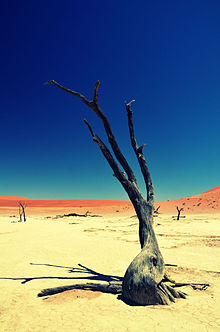Deadvlei
The Deadvlei (from English dead 'tot' and Afrikaans vlei [ fləi̯ ] as a collective name for the mostly dry end of a desert river), also written Dead Vlei , is a small clay pan surrounded by dunes in the Namib Sand Sea in Namibia . The Deadvlei is part of the Namib-Naukluft National Park and, like the nearby Sossusvlei in the north and east, is geotouristically marketed.
description
The base of the Deadvlei (without dune slopes) is an ellipse stretched in a northwest-southeast direction with a size of around 0.6 square kilometers (60 hectares). The main body of " Big Daddy " (also called "Crazy Dune") rises above the southeastern end of the valley , at around 350 m one of the highest sand dunes in the world. The sand ridges that flank the Deadvlei in the northeast and southwest are two branches of this large dune. At the northwestern end, the Deadvlei is open to the Tsauchab , one of the large blind ending dry rivers of the Namib Sand Sea. The surface of the valley floor is mainly formed by a whitish, cracked clay - silt layer, which in aerial photos clearly stands out from the darker, reddish surrounding dunes.
The many dead camel thorn trees ( Vachellia erioloba ) in its northwestern half are characteristic and eponymous for the Deadvlei . Due to the extreme drought, they rot very slowly and have therefore been preserved to this day. Radiocarbon dating of the wood showed that the tree skeletons are around 850 years old and that the trees died in the second half of the 14th and first half of the 15th centuries. In addition to sedimentological findings, they testify that the Tsauchab carried more or more water over 600 years ago and that it must have been more humid in the Deadvlei at that time. The determined period for the death suggests a connection between the decreasing water flow of the Tsauchab and the onset of the Little Ice Age .
At the foot of the dunes and in the few edge areas where the surface is not sealed by the clay-silt crust, individual spots with low vegetation indicate that small amounts of rainwater seep into the gap between the grains of the sand and down into the depression. Animals also live in Deadvlei, including geckos in the sand , birds live in the camel thorn trees and oryxes roam the landscape.
Trivia
The Deadvlei was the location for the opening scene of the film The Cell in 2000 .
Web links
literature
- Peter Bridgeford, Marilyn Bridgeford: Sesriem and Sossusvlei. Experience the desert. Walvis Bay 2012, ISBN 99916-68-20-9 .
- George A. Brook, Pradeep Srivastava, Eugene Marais: Characteristics and OSL minimum ages of relict fluvial deposits near Sossus Vlei, Tsauchab River, Namibia, and a regional climate record for the last 30 ka. Journal of Quaternary Science. Vol. 21, No. 4, 2006, pp. 347–362, doi: 10.1002 / jqs.977 (alternative full text access : ResearchGate )
Individual evidence
- ^ Klaus Heine, Flood Reconstructions in the Namib Desert, Namibia and Little Ice Age Climatic Implications: Evidence from Slackwater Deposits and Desert Soil Sequences. Journal of the Geological Society of India. Vol. 64, No. 4, 2004, pp. 535-547 ( PDF 433 kB)
- ^ Fauna - Sossusvlei.com. Retrieved January 14, 2020 .
- ↑ Filming locations of The Cell in the IMDb, accessed September 4, 2019
Coordinates: 24 ° 46 ′ S , 15 ° 18 ′ E


